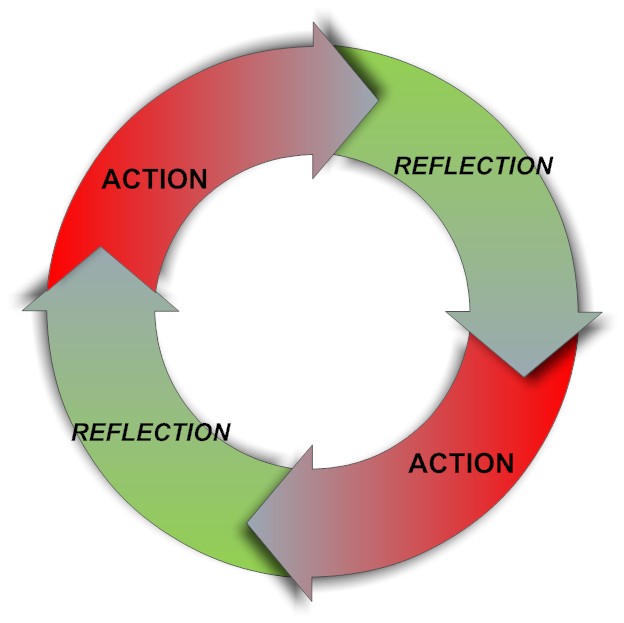The Power of Customer Action/Reflection/Action
I write and speak frequently about the distinction between busy vs. effective. Lots of people are busy. Few are truly effective. It is essential that you know the difference. Is the action you’re taking effective?
When the marketplace is constantly changing, how do you know that the action you are taking as a company is effective?
Let’s assume for a moment that it is and that you’ve been immersed in effective action for a period of time. How do you know that your next actions will still be effective?
 The key is to create an Action-> Reflection-> Action cycle. You take action with customers. You pause to reflect on that action. You now take new actions that are more effective.
The key is to create an Action-> Reflection-> Action cycle. You take action with customers. You pause to reflect on that action. You now take new actions that are more effective.
As an individual, this is a great practice. If you are leading others, it is absolutely crucial that you drive this Action->Reflection->Action cycle for your company.
One of the most critical jobs for a leader is to continuously create context. Since you generally have a broader perspective than those who work for you, you must connect the dots and create meaning out of the changes in the marketplace. Your people need to have trust and confidence that the business is well positioned and that they have a bright future. If you aren’t communicating this on a regular basis, they will start to wonder. Often your employees are so focused on day to day activities or focused on only one aspect of the business that they need help seeing the big picture. Your job is to continuously paint that big picture and communicate it so that they see what you see.
So how do you go about painting that picture? Action->Reflection->Action.
As an example, here’s an exercise I recently assigned to one of my clients and we just reviewed it together. He’d been extremely action-focused over the past couple of months, preparing his team to make six large proposals to different potential clients. This flurry of activity and creative energy resulted in significant new business, which he then had to rapidly hire to backfill for the business he’d just sold.
The assignment ? Block out 30 minutes on your calendar. Make a list of every potential client that you pitched to over the past three months. Now, go through them one at a time. Write down the key issues that your potential client faced. Not the surface issues, but the real ones that you discovered once you got into the conversation. What did you learn from that client? Now, look at your own game film. What was the outcome with that client? What did you do well? Where could you improve?
Once you’ve completed the one by one review, go back and look at the entire list. What are the common themes? What are the marketplace trends?
Now for implications and actions. What does this mean for us? What opportunities are there to grow and generate new business with our current or prospective clients? What did you consistently do well that you want more of? Where are your biggest opportunities for improvement?
After completing this reflection, my client realized that there are a few common issues that his clients face and that his firm solves really well. Yet these issues lie below the surface and only came up later in the sales process. The next action? How can we raise those issues earlier in the process – so that our clients understand that we really understand their issues – and then better position our firm to win the business.
Once you do this reflection, you need to share it with your key stakeholders internally. If you are going to redirect action, you need to create context first. Sit down with your leadership team and show them – here’s what I’m seeing. What are you seeing? Share your reflections with your direct reports and associates – here’s what we are seeing overall in the business. Here’s where we have big opportunities, and here’s where we need to make some shifts. Your colleagues and associates will really appreciate this communication.
At the end of the exercise, the client said “Wow, that was really valuable. I didn’t realize how much insight is sitting right there in my calendar. Everyone senses these things, but this reflection really brings them to the surface. But you do have to create the time to do it.”
Exactly. And leaders often miss that point. It is a core part of your job.
Ready to do this for your business? Here’s how:
- Review your calendar for the past 90 days.
- Make a list of the clients you served during that period.
- Make a list of the prospective clients you talked with over that period.
- Now go through the list one at a time and identify the key issues, key learnings, successes, and opportunities.
- Now go back through the entire list and identify the big themes.
- Share your findings with the right people and get agreement on the next actions to take.
- Go do it.
Remember that a key part of leadership communication is continuing to paint the big picture and showing how your company fits into it, what opportunities you see, and what action you can take right now to seize them. But if you don’t take the time to clearly see the opportunity, how can you seize it?


Ron, Thank you for this blog. Lots of great quotes and take aways.